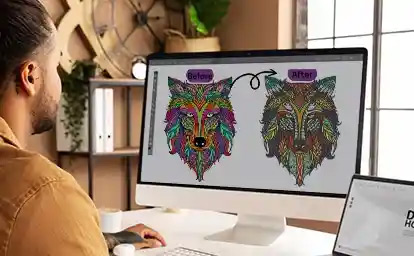Introduction
Embroidery digitizing is where art meets technology – transforming your beautiful designs into stitch-perfect reality. This magical process converts your artwork into digital instructions that embroidery machines can follow, but with dozens of software options available, how do you choose the best embroidery digitizing software for your creative workflow?
The right software makes all the difference between frustrating trial-and-error and professional-quality results from your first attempt. Whether you’re a fashion designer incorporating embroidery into your collection, a small business owner creating custom apparel, or an artist exploring textile mediums, this comprehensive guide will walk you through the top digitizing solutions. We’ve personally tested all the major programs to bring you an honest comparison of features, learning curves, and real-world performance.
From free beginner-friendly options to industrial-grade professional suites, we’ll help you find the best embroidery digitizing software that matches your skill level, budget, and creative ambitions. Discover which programs excel at automatic conversions, which offer the most precise manual controls, and which provide the perfect balance of both.
What Makes Best Embroidery Digitizing Software?
Before we dive into specific programs, let’s look at the key features professionals value most:
Core Capabilities:
- Precision editing tools (stitch-by-stitch control)
- Automatic digitizing (with manual override)
- Material presets (optimized for different fabrics)
- 3D visualization (accurate stitch simulation)
Workflow Essentials:
- Multi-format export (DST, PES, EXP, JEF, etc.)
- Color management (Pantone matching)
- Version control (saving incremental edits)
Top Professional-Grade Software
1. Wilcom Hatch Embroidery
Best for: Full-time digitizers and businesses
Standout Features:
- Industry-leading stitch engine
- Photorealistic stitch simulation
- Advanced lettering tools
Price: $1,200+ (one-time purchase)
2. Pulse IDS
Best for: Corporate and industrial users
Standout Features:
- Powerful auto-digitizing
- Excellent vector conversion
- Team collaboration tools
Price: $3,000+
3. Tajima DG/ML by Pulse
Best for: High-volume production
Standout Features:
- Unmatched stitch optimization
- Multi-head machine support
- Batch processing
Price: $5,000+
Best Mid-Range Options
1. Embrilliance
Best for: Mac users and small businesses
Standout Features:
- Modular pricing (buy only what you need)
- Intuitive interface
- Excellent community support
Price: $129-$599
2. SewArt
Best for: Beginners transitioning to pro
Standout Features:
- Affordable one-time purchase
- Good auto-tracing
- Simple learning curve
Price: $39-$79
3. BuzzTools
Best for: Quick edits and repairs
Standout Features:
- Lightning-fast performance
- Specialized repair tools
- Clean file conversion
Price: $199
Free & Open Source Options
1. Ink/Stitch
Best for: Designers already using Inkscape
Pros:
- Completely free
- Works with vector graphics
- Active developer community
Cons: - Steeper learning curve
- Limited advanced features
2. SophieSew
Best for: Basic home embroidery
Pros:
- Simple interface
- Good starter tool
- Windows/Mac compatible
Cons: - No professional features
- Limited file formats
Specialized Software by Need
For Fashion Designers:
- Modaris Embroidery (integrates with Lectra)
- Optitex 3D Embroidery
For Quilters:
- Bernina Embroidery Software
- Quiltography
For Small Businesses:
- EmbroideryWare
- Stitch Era
Key Decision Factors
1. Budget Considerations
- Free tools work for occasional use
- $100-$500 range offers good features
- $1,000+ unlocks industrial capabilities
2. Learning Curve
- Some programs take 100+ hours to master
- Look for tutorial availability
- Consider your technical comfort level
3. Output Requirements
- Hobbyists need basic formats
- Professionals require industrial compatibility
- Check your machine’s specific needs
Software Feature Comparison
| Feature | Wilcom | Embrilliance | Ink/Stitch |
|---|---|---|---|
| Stitch Editing | ★★★★★ | ★★★★ | ★★★ |
| Auto-Digitizing | ★★★★ | ★★★ | ★★ |
| 3D Preview | ★★★★★ | ★★★ | – |
| Price | $$$$ | $$ | Free |
Pro Tips for Choosing
- Try Before You Buy
Most paid software offers free trials - Check Hardware Requirements
Some programs need powerful graphics cards - Consider Future Needs
Will you outgrow entry-level software? - Look at Training Resources
Good tutorial libraries shorten learning time
Common Beginner Mistakes
1. Overestimating Auto-Digitize
Even the best software needs manual tweaking
2. Ignoring File Compatibility
Not all software creates all machine formats
3. Skipping Practice Time
Digitizing is a skill that takes hours to develop
The Future of Digitizing Software
Emerging trends to watch:
- AI-assisted digitizing (automated stitch optimization)
- Cloud collaboration (team editing capabilities)
- AR previews (see designs on garments before stitching)
Conclusion
Choosing embroidery digitizing software is about matching capabilities to your specific needs. While Wilcom dominates the professional market, excellent options exist at every price point.
Quick Recommendations:
- Total beginners: Start with SewArt or Ink/Stitch
- Growing businesses: Embrilliance offers great value
- Professional digitizers: Invest in Wilcom or Pulse
Remember that software is just a tool – your creativity and practice will determine the real quality of your digitized designs. Which software are you most excited to try first?



